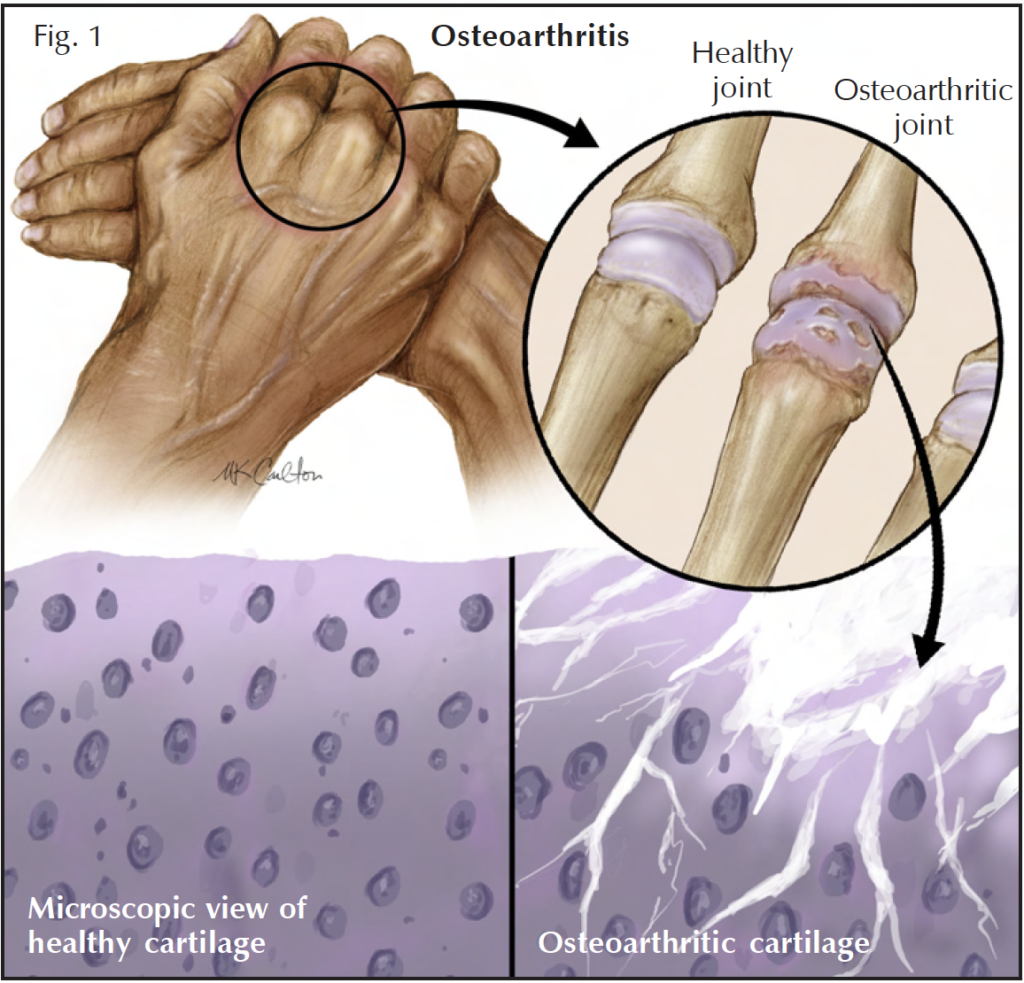Contributing physicians in this story

Do you have pain, stiffness, or redness in one or more of your joints? Are your fingers swollen and deformed? Is you hip or knee sore and stiff after you’ve been walking or exercising? Have you ever experienced a sudden attack of pain and swelling in your big toe in the middle of the night?
All of these symptoms may be caused by arthritis, a condition that affects millions of people of all ages and from all walks of life. The questions are what kind of arthritis and what can be done to treat these aches and pains, the stiffness and swelling, and the difficulty in moving fingers, knees (Fig 1), or hips?
The more you know about your disease, the better you will be able to adapt. It is helpful to know that most people with arthritis are able to lead productive lives, although activities may need to be modified to help preserve joint function.
What is arthritis?
Arthritis is not a single disorder but a general term used to describe a number of different conditions that cause acute or chronic inflammation of one or more joints. These conditions are usually accompanied by pain, swelling, stiffness, redness, and frequently, changes in the joint’s physical structure. The most common forms of arthritis are osteoarthritis (Fig 2), rheumatoid arthritis, and gout.
Arthritis affects people in different ways. Depending on its form and severity, one joint or many may be involved. The pain can vary from mild to severe. Some individuals may have long periods of no pain interspersed with episodes of sudden, unexpected attacks. Others may experience long-term mild aches, stiffness, and inconvenience. Some people may suffer severe pain, joint deformity, and difficulty walking or using their fingers.
How can arthritis be treated?
Treatment is tailored to the individual needs of each patient. Although there is no known cure for the primary types of arthritis, early diagnosis can be very important. Treatment can help reduce inflammation, alleviate pain, maintain and improve joint function, correct joint deformity, and minimize subsequent disabilities. A comprehensive treatment program includes medications, diet therapy, physical therapy, and occupational therapy.
Anti-inflammatory drugs are frequently used to provide relief from the pain and to reduce the inflammation associated with osteoarthritis and rheumatoid arthritis. For severe cases of inflammation, a corticosteroid may be injected directly into the affected joint to relieve pain and to restore mobility. However, because these injections can have adverse effects on the joint cartilage, they must be used cautiously. Specific medications, along with diet therapy, may be used to control gout.

Physical therapy may include supervised exercises to strengthen your muscles and to help you maintain joint flexibility; various types of heat and cold therapy; guidelines for balancing exercise with rest; and posture rules to assist you in standing, sitting, and lying correctly. People who are obese are advised to lose weight if they have arthritis in any of their weightbearing joints, such as the hips or knees.

Occupational therapy is directed at helping you adapt to a lifestyle within the limitations of your condition and at minimizing the stresses placed on the involved joints. Special assistive devices can be used to achieve these goals. For patients whose joints are so badly damaged or unstable that their pain cannot be controlled or their disabilities cannot be corrected by nonsurgical methods, orthopaedic surgery may be necessary. Surgical techniques have advanced greatly in the past 10 years and are very effective in relieving debilitating pain and in improving the patient’s level of activity. The type of surgery that is selected depends on the patient’s individual condition. Diseased tissue may be removed from the arthritic joints, bones in the joint may be fused together (arthrodesis), or the joint may be replaced with an artificial substitute (arthroplasty).
Author: Fred Flandry, MD | Columbus Georgia
Reprinted from the Hughston Health Alert, Volume 4, Number 3, Summer 1992.
Last edited on October 18, 2021